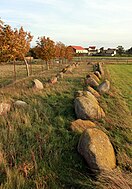Great stone graves near Gehrden
| Great stone graves near Gehrden | ||
|---|---|---|
|
The Gehrden giant bed |
||
|
|
||
| Coordinates | 52 ° 0 ′ 35.8 " N , 11 ° 57 ′ 14.5" E | |
| place | Zerbst / Anhalt , Saxony-Anhalt , Germany | |
| Emergence | 3500 to 2800 BC Chr. | |
The megalithic graves near Gehrden were originally three Neolithic megalithic graves near Gehrden , a district of the city of Zerbst / Anhalt in the Anhalt-Bitterfeld district in Saxony-Anhalt . Of these, only one still exists today, which is also the only surviving chamberless giant bed in Saxony-Anhalt. The other two graves were destroyed in the 18th or early 19th century.
location
The preserved grave is on the northwestern outskirts of Gehrden on a meadow and is accessible via a road. The destroyed grave 2 was located west or south-west of Gehrden on a hill on the border with Gödnitz. The destroyed grave 3 was immediately south of Gehrden on the meadow west of the Neue Reihe street. It was built over by a windmill that no longer exists today .
Research history
The graves in Gehrden were first mentioned by Johann Christoph Bekmann in his Historie Des Fürstenthums Anhalt , published in 1710 . Joachim Gottwalt Abel , who was pastor in Möckern between 1755 and 1806 , provided a more detailed description of the facilities . He left only handwritten notes on this, which were published by Ernst Herms in 1928 . When Herms' investigations, only one grave remained, the others had already been completely removed.
description
The preserved grave
The preserved grave belongs to the type of chamberless megalithic beds and as such represents the only surviving large stone grave of this type in Saxony-Anhalt. The megalithic bed is rectangular and oriented southeast-northwest. It thus deviates from the east-west orientation that is usual in the area. The barren bed has a length of 51 m and a width of 5.8 m. Of the original 65 stones, 58 are still preserved. Some are missing on the north-eastern long side and on the narrow sides. 18 stones protrude more than 1 m from the earth. A particularly large, overturned corner stone is 2.8 m long and 1.3 m wide.
A stone of the enclosure was used for a war memorial in the Gehrden cemetery after the First World War .
Ceramics from the spherical amphora culture were found in the megalithic bed .
The destroyed graves
Garb 2
Grave 2 was smaller than the existing structure and was already in poor condition when Abel examined it. It was built on sandy ground. Many stones had already overturned or been relocated due to sand mining. Information on the dimensions of the system is not available. It is not known whether the complex originally had a stone burial chamber. The exact type of grave can therefore not be determined with certainty.
Grave 3
The facility had a north-south oriented megalithic bed, which at the time of Abel's investigation had already been severely destroyed by the construction of a windmill. Abel could only find 15 stones in the southern half of the bed. There were nine on the eastern and six on the western long side. Information on the dimensions of the system is not available. It is not known whether the complex originally had a stone burial chamber. The exact type of grave can therefore not be determined with certainty.
See also
literature
- Hans-Jürgen Beier : The sphere amphora culture in the Middle Elbe-Saale area and in the Altmark (= publications of the State Museum for Prehistory in Halle. 41). Deutscher Verlag der Wissenschaften, Berlin 1988, ISBN 3-326-00339-0 , p. 98.
- Hans-Jürgen Beier: The megalithic, submegalithic and pseudomegalithic buildings as well as the menhirs between the Baltic Sea and the Thuringian Forest . Contributions to the prehistory and early history of Central Europe 1. Wilkau-Haßlau 1991, p. 63.
- Johann Christoph Bekmann : History of the Principality of Anhalt From its old inhabitants and some of the old monuments that were still available / natural life / division / rivers / towns / spots and villages / Fürstl. Highness / Stories of the Prince. People / religious acts / princely ministries, aristocratic families / scholars / and other bourgeois class noble people. 1st - 4th Part, Zerbst 1710, pp. 25-27 ( online version ).
- Ernst Herms : The megalithic graves of the Jerichow I district . In: Festschrift of the Magdeburg Museum for Natural History and Local History for the 10th Conference on Prehistory , Magdeburg 1928, p. 252.
- Joachim Preuss : The Altmark group of deep engraving ceramics (= publications of the State Museum for Prehistory in Halle. Volume 33). Deutscher Verlag der Wissenschaften, Berlin 1980, p. 127.
- Hans Priebe : The western group of spherical amphorae (= annual publication for the prehistory of the Saxon-Thuringian countries. Volume 28). Gebauer-Schwetschke, Halle 1938, p. 81.
- Britta Schulze-Thulin : Large stone graves and menhirs. Saxony-Anhalt • Thuringia • Saxony . Mitteldeutscher Verlag, Halle (Saale) 2007, ISBN 978-3-89812-428-7 , pp. 62-64.
Web links
- The Megalithic Portal: Gehrden Long Bed
- KLEKs Online: Großsteingrab Gehrden
- grosssteingraeber.de: The giant bed near Gehrden
- tw.strahl.org: "Gehrden" large stone grave , Gehrden northwest of Zerbst
- cruptorix.nl: Gehrden
Individual evidence
- ↑ Schulze-Thulin, p. 64.


